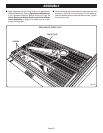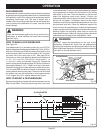
Page 28
OPERATION
■ Make sure the wood is clear of the blade before turning on
the saw.
See Figure 35.
■ To turn saw ON, lift switch cover and press switch button.
Then lower switch cover.
■ To turn saw OFF, (A) press or push outside of switch
cover, or (B) lift switch cover and press switch button.
See
Figure 36
.
Note: To prevent unauthorized use, lock your saw in the
Off position with a padlock as shown in figure 36.
■ Let the blade build up to full speed before moving the
miter table to feed the workpiece into the blade.
■ Hold the work firmly against the miter fence with both
hands and push the miter table to feed the work into the
blade.
TO MAKE A MITER CUT
See Figure 37.
It is recommended you make test cuts on scrap wood.
WARNING:
Make sure the blade guard assembly is installed and
working properly to avoid serious personal injury.
■ Remove the rip fence by lifting the locking handle.
■ Loosen the adjusting clamp to set the desired angle of the
miter fence. Place the miter indicator on the miter fence
to the desired angle on the miter table. Retighten the
clamp.
■ Place a support (the same height as saw table) behind the
saw for the cut work.
■ Make sure the miter fence will not contact the blade while
feeding the wood. Make a trial pass of the miter table. The
miter fence should not contact the blade. Loosen the
adjusting clamp to move it away from the blade if needed.
■ Make sure the wood is clear of the blade before turning on
the saw.
■ Let the blade build up to full speed before moving the
miter table to feed the workpiece into the blade.
■ Hold the work firmly against the miter fence with both
hands, keeping well clear of the blade, and push the miter
table to feed the work into the blade.
TO MAKE A STRAIGHT RIP CUT
See Figure 38.
It is recommended you make a test cut on scrap wood.
WARNING:
Make sure the blade guard assembly is installed and
working properly to avoid serious personal injury.
■ Remove the miter fence. Position accessory table and
sliding miter table to provide the support necessary for
the cut being performed. Securely lock the rip fence with
the locking handle.
■ Don't leave one side of saw unsupported.
■ Position the rip fence the desired distance from the blade
for the cut and securely lock the handle. Adjust the scale
to zero at the cutting edge of the blade.
■ Place a support (the same height as saw table) behind
the saw for the cut work.
■ Use a push block or push stick to move the wood through
the cut past the blade. Never push a small piece of
wood into the blade with your hand, always use a
push stick. The use of push blocks, push sticks, and
featherboards are necessary when making non-through
cuts.
■ Stand to the side of the wood as it contacts the blade to
reduce the chance of injury should kickback occur. Never
stand directly in the line of cut.
■ Make sure the wood is clear of the blade before turning
on the saw.
■ Let the blade build up to full speed before feeding the
workpiece into the blade.
Fig. 38
RIP FENCE
BLADE
MITER TABLE
PUSH STICK
REAR RAIL
BASE
FRONT RAIL
LOCKING HANDLE
Fig. 37
MITER FENCE
BLADE
GUARD ASSEMBLY
ADJUSTING CLAMP


















